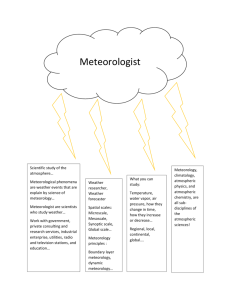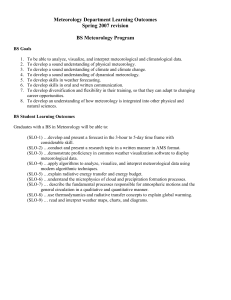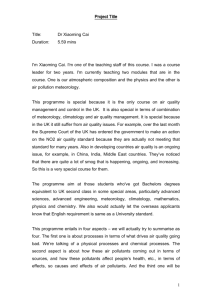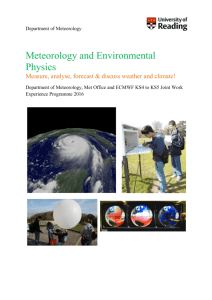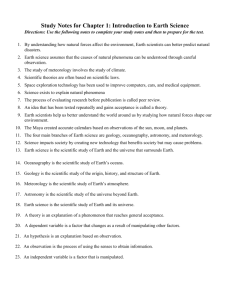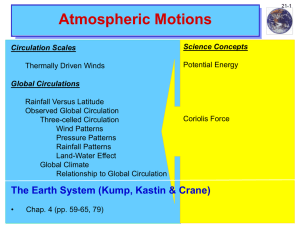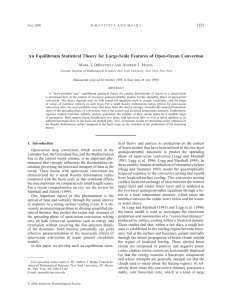Syllabus
advertisement
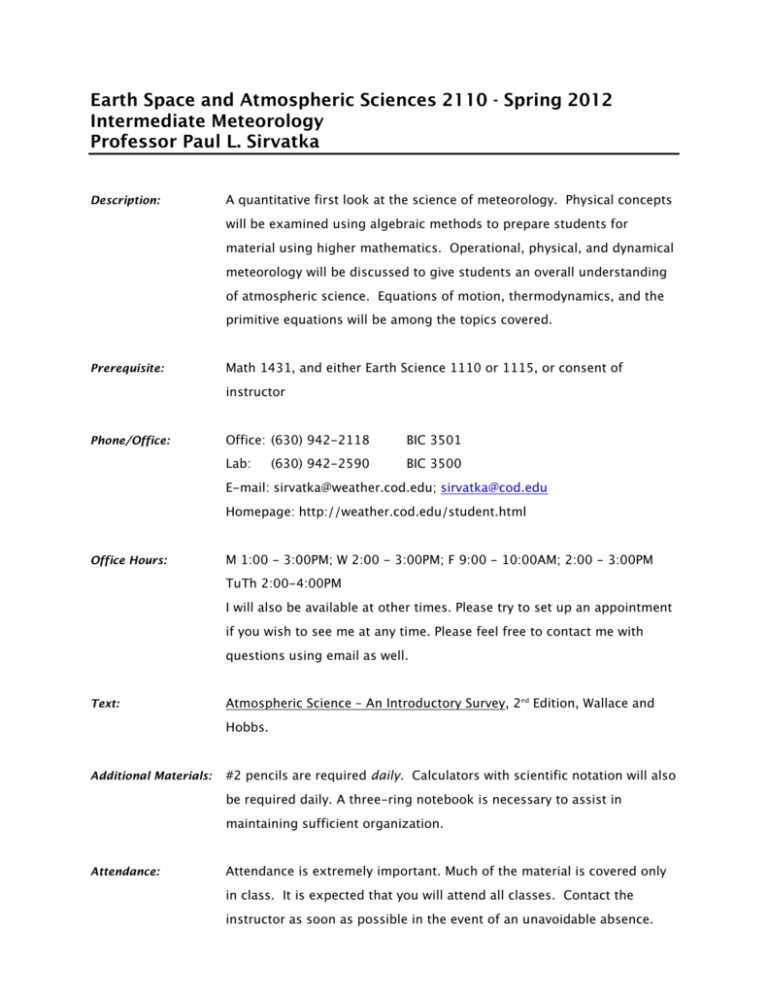
Earth Space and Atmospheric Sciences 2110 - Spring 2012 Intermediate Meteorology Professor Paul L. Sirvatka Description: A quantitative first look at the science of meteorology. Physical concepts will be examined using algebraic methods to prepare students for material using higher mathematics. Operational, physical, and dynamical meteorology will be discussed to give students an overall understanding of atmospheric science. Equations of motion, thermodynamics, and the primitive equations will be among the topics covered. Prerequisite: Math 1431, and either Earth Science 1110 or 1115, or consent of instructor Phone/Office: Office: (630) 942-2118 BIC 3501 Lab: BIC 3500 (630) 942-2590 E-mail: sirvatka@weather.cod.edu; sirvatka@cod.edu Homepage: http://weather.cod.edu/student.html Office Hours: M 1:00 - 3:00PM; W 2:00 - 3:00PM; F 9:00 - 10:00AM; 2:00 - 3:00PM TuTh 2:00-4:00PM I will also be available at other times. Please try to set up an appointment if you wish to see me at any time. Please feel free to contact me with questions using email as well. Text: Atmospheric Science – An Introductory Survey, 2nd Edition, Wallace and Hobbs. Additional Materials: #2 pencils are required daily. Calculators with scientific notation will also be required daily. A three-ring notebook is necessary to assist in maintaining sufficient organization. Attendance: Attendance is extremely important. Much of the material is covered only in class. It is expected that you will attend all classes. Contact the instructor as soon as possible in the event of an unavoidable absence. Labs and quizzes cannot be made up. Only in exceptional circumstances can tests be given at a time other than the announced date. Exceptions must be pre-arranged. A missed test is a zero. Grading: Unit exams ~ 70% Homework ~ 10% Final Project ~ 20% Grades will be curved based upon expected results and class participation and attitude. Generally speaking, the grades will be as follows: A – 80%; B – 70%; C – 50%; D – 40%; F < 40% All work must be completed. An incomplete will be given only in an exceptional circumstance. It is the student's responsibility to withdraw from the course due to non-attendance. Failure to withdraw will result in an "F". Late assignments will be penalized to a maximum credit of 50% at the discretion of the instructor. Students wishing to take this course on a pass/fail basis must earn a grade of a "C" or higher to receive a "Satisfactory" for the course. In order to fulfill the general education requirements a letter grade must be received. Course Objectives: Upon successful completion of this course the student should be able to do the following: 1. Define and use various forms of foundational physical laws as they relate to meteorology, including the Ideal Gas Law, the 4 Laws of Thermodynamics, and Newton’s Laws of Motion 2. Define scale height and use it in expressing vertical distributions of pressure and density 3. Derive the virtual temperature 4. Derive the hypsometric equation from the hydrostatic equation and the Ideal Gas Law 5. Define and contrast the specific heat of air at constant pressure and at constant volume 6. Derive potential and equivalent potential temperature 7. Explain a Carnot heat engine and determine the work, efficiency, and changes in entropy of atmospheric processes that liken an engine 8. Differentiate between various uses of the Del operator 9. Convert zonal, meridional and vertical velocities from Cartesian to spherical coordinates 10. Evaluate and interpret a total derivative 11. Differentiate between an Eulerian and LaGrangian description of motion 12. Formulate the Coriolis force from the earth’s apparent centrifugal force 13. Express the pressure gradient force in Cartesian and natural coordinates 14. Define the geostrophic and gradient balance and calculate corresponding wind velocities 15. Differentiate between trajectories and streamlines 16. Interpret the significance of the thermal wind in baroclinic disturbances 17. Differentiate between a barotropic, equivalent barotropic, and baroclinic atmosphere 18. Explain a method for expressing mass continuity and interpret its results 19. Summarize the primitive equations 20. Describe the development of thermally direct and thermally indirect circulations 21. Define baroclinic instability in qualitative terms 22. Describe the energy cascade 23. Summarize blackbody radiation and its governing laws Expectations: The student is expected to attend all classes, participate fully in classroom discussions and cooperate in learning experiences with other classmates. The expected workload is two hours of work for every hour of time spent in class. This will vary from week to week with some weeks having more work required and other weeks having less. Nonetheless, because this class is a sophpmore level course, higher quality work is expected. Final Exam: A final exam will be given. See http://www.cod.edu/schedule/ for a listing of the final schedule. The following list represents things meteorology majors at COD ought to know before leaving our program. Most of these things will be covered in this class. However, some are covered well in in other classes. The final project will be to discuss thoroughly each one of these, professionally and with diagrams. This should be something that you will use the rest of your academic career. 1. Bergeron Process 2. Buys-Ballot Law 3. Chinook, Santa Ana and Katabatic Winds 4. Cloud Types 5. Conservation of Angular Momentum 6. Derivation of Poisson’s Equation 7. Energy Cascade 8. Facts about the Geostrophic Wind 9. Four Laws of Thermodynamics 10. Geostrophic Equation 11. Global Warming vs. the Greenhouse Effect 12. Gradient Winds 13. Hydrostatic Equation 14. Hypsometric Equation 15. Ideal Gas Law 16. Instability (Absolute/Conditional) 17. Jet Streak and Associated Circulations 18. Mass Continuity Equation 19. Newton’s 3 Laws of Motion 20. Q-G Omega Equation (Qualitative) 21. Rayleigh Scattering (Why is the Sky Blue?) 22. Sea Breeze/Land Breeze Circulations 23. Station Model (Surface/Upper Air) 24. Stephan-Boltzmann Law 25. Thermal Wind 26. Thermally Direct/Indirect Circulations 27. Thermodynamic Diagram 28. Three-Cell Model 29. Virtual Temperature 30. Wien’s Displacement Law

